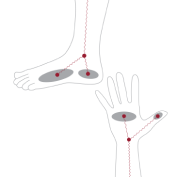InBody Body Composition Q&A

What is Body Composition?
Health professionals use body composition to evaluate a person’s weight by breaking it down into its core components: fat, protein, minerals, and body water. It describes your healthy weight more accurately and provides a better glimpse into your overall health than traditional methods like BMI & weight. Body composition analysis can accurately show changes in fat mass, lean muscle mass, and body fat percentage.
Why Is Body Composition Important To Measure?
Most diet and fitness goals focus on weight loss or gain, overlooking that two people of the same sex and body weight may look completely different because they have different body compositions. Measuring your body composition will tell you your own body’s unique makeup and help you identify areas to work on to improve your overall health and wellness.
Getting a better insight into your overall wellness starts with measuring your body composition and going beyond the number on the scale. You will know whether you need to gain more lean mass or lower body fat percentage to achieve a healthy body composition and better health.
What is the InBody Test?
What does your weight represent? When you step on a scale, you can’t see how much muscle or fat you have—all you see is a number with no context.
Go beyond the scale with the InBody Test, a non-invasive, quick, and accurate body composition analysis that provides a detailed breakdown of your weight in terms of muscle, fat, and water. Your comprehensive yet easy-to-understand measurements will display on an InBody Result Sheet in 15-120 seconds, depending on the model. No more pinching. No more dunking. Get results you can trust so you can reach your health and fitness goals with precision and actionable objectives.
What makes InBody Technology Different?
Traditional BIA technology measures the human body as a single cylinder using one frequency, which increases the likelihood of inaccurate results.
Conventional BIA devices use empirical estimations based on factors like age and sex to help improve accuracy. While this may work for people with a standard body type, it is inaccurate for those who do not fit this mold, such as fit elderly adults.
Everyone has a unique body composition, so InBody makes innovative technology tailored to the individual, not a group.
InBody’s medical-grade body composition analyzers use four pillars of technology to provide accurate, precise direct segmental measurement multi-frequency bioelectrical impedance analysis (DSM-MFBIA) extensively validated to gold-standard methods.
What is Bioelectrical Impedance Analysis (BIA)?
Bioelectrical impedance analysis (BIA) measures body composition, including muscle mass, body fat, and total body water. Alternating low and high-frequency electrical currents are sent through the water in the body via contact with electrodes to measure impedance.
The impedance determines total body water (TBW), which can then be used to derive your fat-free mass—the portion of your body that does not contain fat, including your muscle and bone—and body fat.

Multiple Frequencies
InBody uses multiple currents at varying frequencies to provide precise body water analysis.

8-Point Tactile Electrode System
Contact resistance occurs when measuring impedance with electrodes. InBody accounts for contact resistance with strategically placed electrodes to ensure accurate and reproducible measurements.

Direct Segmental Measurements
InBody measures each of the body’s five cylinders (left arm, right arm, torso, left leg, and right leg) to deliver accurate and detailed results.

No Empirical Estimations
InBody measures your impedance independently, so your results are not affected by age, sex, ethnicity, athleticism, or body shape.

